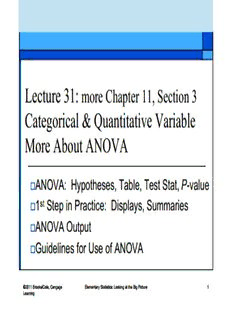
Categorical & Quantitative Variable More About ANOVA PDF
Preview Categorical & Quantitative Variable More About ANOVA
Lecture 31: more Chapter 11, Section 3 Categorical & Quantitative Variable More About ANOVA ANOVA: Hypotheses, Table, Test Stat, P-value 1st Step in Practice: Displays, Summaries ANOVA Output Guidelines for Use of ANOVA ©2011 Brooks/Cole, Cengage Elementary Statistics: Looking at the Big Picture 1 Learning Looking Back: Review 4 Stages of Statistics Data Production (discussed in Lectures 1-4) Displaying and Summarizing (Lectures 5-12) Probability (discussed in Lectures 13-20) Statistical Inference 1 categorical (discussed in Lectures 21-23) 1 quantitative (discussed in Lectures 24-27) cat and quan: paired, 2-sample, several-sample 2 categorical 2 quantitative ©2011 Brooks/Cole, Elementary Statistics: Looking at the Big Picture L31.2 Cengage Learning ANOVA Null and Alternative Hypotheses : explanatory C & response Q not related Equivalently, (difference among sample means just chance) : explanatory C & response Q are related Equivalently, : not all the are equal (difference too extreme to be due to chance) Depending on formulation, the word “not” appears in H or H . o a ©2011 Brooks/Cole, Elementary Statistics: Looking at the Big Picture L31.5 Cengage Learning Example: How to Refute a Claim about “All” Background: Reader asked medical advice columnist: “Dear Doctor, does everyone with Parkinson’s disease shake?” and doctor replied: All patients with Parkinson’s disease do not shake. Question: Is this what the doctor meant to say? Response: ©2011 Brooks/Cole, Elementary Statistics: Looking at the Big Picture L31.7 Cengage Learning Example: ANOVA Alternative Hypothesis Background: Null hypothesis to test for relationship between race (3 groups) and earnings: Question: Is this the correct alternative? Response: Words are better: say “_________________________”. ©2011 Brooks/Cole, Elementary Statistics: Looking at the Big Picture L31.9 Cengage Learning The F Statistic (Review) Numerator: variation among groups How different are from one another? Denominator: variation within groups How spread out are samples? (sds ) ©2011 Brooks/Cole, Elementary Statistics: Looking at the Big Picture L31.10 Cengage Learning Role of Variations on Conclusion (Review) Boxplots with same variation among groups (3, 4, 5) but different variation within: sds large (left) or small (right) var among Scenario on right: smaller s.d.s larger F = var within smaller P-value likelier to reject Ho conclude pop means differ ©2011 Brooks/Cole, Elementary Statistics: Looking at the Big Picture L31.11 Cengage Learning ANOVA Table Organizes calculations “Source” refers to source of variation DF: use I = no. of groups, N = total sample size SSG measures overall variation among groups SSE measures overall variation within groups Mean Sums: Divide Sums by DFs F: Take quotient of MSG and MSE P-value: Found with software or tables ©2011 Brooks/Cole, Elementary Statistics: Looking at the Big Picture L31.15 Cengage Learning Example: Key ANOVA Values Background: Compare mileages for 8 sedans, 8 minivans, 12 SUVs; find SSG=42.0, SSE=181.4. Question: What are the following values for table: DFG? DFE? MSG? MSE? F? Response: DFG = 3 – 1 = 2 DFE = N – I = (8+8+12) – 3 = 25 MSG = SSG/DFG = 42/2 = 21 MSE= SSE/DFE = 181.4/25 = 7.256 F= MSG/MSE = 21/7.256 = 2.89 ©2011 Brooks/Cole, Elementary Statistics: Looking at the Big Picture L31.16 Cengage Learning Example: Completing ANOVA Table Background: Found these values for ANOVA: DFG=3-1= 2 DFE=N-I=(8+8+12)-3= 25 MSG=SSG/DFG=42/2= 21 MSE=SSE/DFE=181.4/25= 7.256 F=MSG/MSE=21/7.256= 2.89 Question: Complete ANOVA table? Response: SoftwareP-val=0.0743marginally significant ©2011 Brooks/Cole, Elementary Statistics: Looking at the Big Picture L31.18 Cengage Learning
Description: